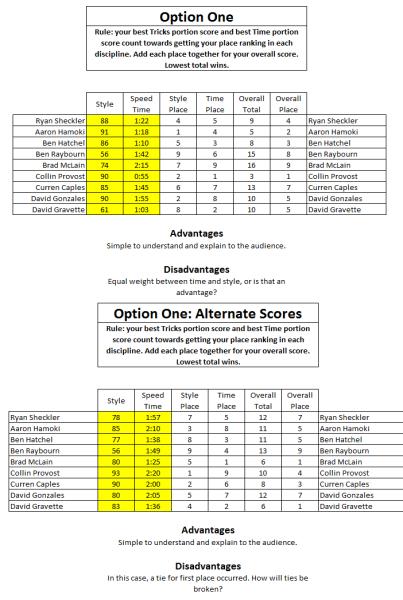Let me warn you, this article and this new feature I'm starting called Skate by Numbers is nerdy, grow'd up, and bid'niss as hell. It has to do with all the things you probably hate in school if you're still stuck in that youth jail. Math, spreadsheets, numbers, addition, multiplication, logic, and all that.
For me, it turned out that paying attention to all that stuff in school meant I could apply it to things I love as an adult and make a living from it. Right now, I'm using all of that to figure out how to structure a skateboarding contest. I want to show you how knowing this dorky stuff can either land you a cool job in skateboarding or give you the skills to make your own job if you're not happy in the one you have.
I'm working on an interesting problem for a new skateboarding shindig where the producers want to possibly factor in times as well as a traditional 0-100 score for a skater's final ranking. How many ways can that be done? Lots. How confusing can it get? Extremely. How many ways can it be done that's easy to explain to a television audience as well as your classic short attention span skateboard rat? Not many.
So, I'm bouncing around ideas on how this can work, looking at other industries that are doing it in their events, and coming up with a few options. Once we get this format nearly locked down, step two is for me to write the software that the judges, producers, and other contest staff will use to run the event, score it, and monitor progress. For some crazy reason, I used to be embarrassed that I liked all that coding and numbers stuff. Now I'm celebrating nerdness like a new superhero with a big N on his chest. This is awesome and challenging stuff to work on.
While we're in development, I'm referring to the two portions of the score as Tricks and Time. One simple option that I saw other "sports" are using is simply taking your place in Tricks and adding it to your place in Time. Lowest overall total wins. I created a spreadsheet with two scenarios of sample data.
As you can see, one random set of scores ended up with a tie in 1st place. I'll go through some more rounds here and see how often that happens and have a plan to solve it if we go with this format and it happens at the live event.
We've got some other ideas we're throwing around on how to factor in the time portion, but it's a tricky balance between being fair, keeping simple and short so the audience doesn't need a chalkboard to understand it, and also making it exciting. Do you have any ideas? I'd like to hear them in the comments. Thanks for reading the first edition of Skate by Numbers. I still can't believe I got to grow up and work on stuff like this in skateboarding.


